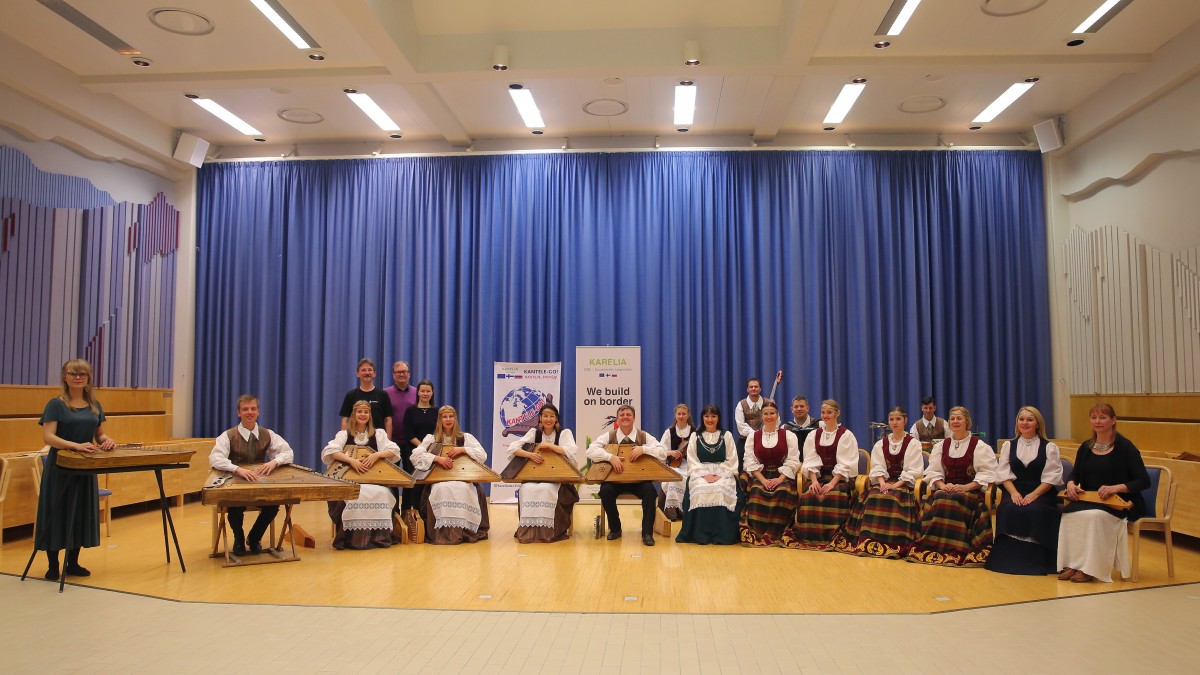The Kantele House in Petrozavodsk
Text by Hanna Ryynänen
Translated by Jane Ilmola
In the picture above: The musicians of the Petrozavodsk Kantele Ensemble with Minna Raskinen and Hanna Ryynänen. In the background also the leader of the Kantele GO!-project, Olga Vlasova, Pekka Huttu-Hiltunen from the Runosong-Academy and the artistic director of the Kantele Ensemble, Vyacheslav Ivanov. Photo from October 2019 as part of the Kantele GO!-project. (photo: Kirill Ognev)
While wandering through the streets of Petrozavodsk one may notice a beautiful light pink house named Dom Kantele (the Kantele House). The building was finished in 1858 and during the course of its long and colorful history it has had many uses.
Formerly the building served, among other things, as different types of schools and since 1986 the Petrozavodsk Kantele Ensemble has been using it. The Kantele Ensemble may have become familiar to Finns through the noted kantele scholar Kari Dahlblom through different stages of his life. Now we will get to learn about the house and the group, as well as their past, present and future!
The kantele ensemble was founded by Viktor Gudkov (1899-1942), scholar and musician, who got acquainted with the kantele in Kantalahti. There he saw Andrej Hokkanen’s kanteles in the museum and was eager to learn more about kanteles and kantele-building on his field trips. Inspired by what he saw, Gudkov developed a family of chromatic kanteles, which included piccolo, prima, alto and bass.
Gudkov founded different kinds of kantele orchestras. In 1936 he founded an orchestra that became the national song and dance ensemble, named Kantele in 1942.

In Gudkov’s chromatic “Eastern Karelian” kantele the strings are on 2 levels, with the notes of the C-major scale above and the other notes below. The chromatic bass kantele is an exception since all the strings are on the same level. Most of the kanteles have 37 or 38 strings and the sounding notes depend on the model of kantele. Thus the notes on the prima kantele are higher than those on the alto kantele, for example.
The basis of the Kantele Ensemble is a group of six chromatic kantele players. The instrumentalists are Irina Shishkanova, Anastasia Krasilnikova, Elena Ankhimova, Aleksandra Sakharova, Aleksandr Ivanov and Aleksandr Gorevanov. The chromatic instruments have been made by Ilmari Kukk and Viktor Chelombitko, diatonic instruments were ordered from Aleksandr Frolov and from Koistinen Kantele Oy in Finland.
In addition to kantele players the ensemble includes Mikhail Krasilnikov (bayan), Sergei Smirnov (percussions), Roman Belyaev (bass), Anna Petunova(violin) and Andrei Tepper (violin). In addition to the instrumentalists Tatiana Peron, Irina Popova, Anastasia Karavaj, Maria Prokhorova, Marina Eyseeva, Marianna Varlamova and Marina Tukkia sing in the group. The repertoire is mainly based on Karelian, Veps, Finnish and Russian traditional music. The group also commissions and performs a variety of compositions from different composers. One of the most important aims of the group has always been to bring forth and preserve the beauty and uniqueness of Karelian culture, as well as developing on it.
Today the Kantele House is a lively center for Karelian culture that has many events throughout the year with the Kantele Ensemble as well as the vocal group Aino, as well as dancers of folk and modern dance and ballet. The concert hall arranges many concerts and the building also houses a music school where over 100 children learn kantele, dance and singing. There is also the workshop of luthier Aleksandr Frolov and a dressmaker’s workshop, where the costumes inspired by Karelian tradition are produced for the Kantele Ensemble.
The Kantele Ensemble performs actively both internationally as well as throughout Russia and the group has about 150 concerts per year. Their tremendous repertoire of over 500 pieces serves to build unique programs and there have been over 60 different concert repertoires in the time of their existence. The artistic director is Vyacheslav Ivanov, who is responsible for building the concert programs and rehearsing the new programs. This year the ensemble’s programs are celebrating the centennial of the Karelian republic.
In addition to the theme year the Kantele Ensemble is devoting much effort to the Kantele GO!- project. This is a program funded by the Karelia CBC -program, which began in January 2019 and will last until August 2021. The project is lead by the assistant president of the Kantele Ensemble, Olga Vlasova. Partners in the project are the Kantele Ensemble, the University of Eastern Finland, Prääsä music school from Karelia and the Runosong-Academy in Kuhmo, Finland. In this time of globalization the preserving and advancing of local culture has been found to be challenging and the main aim of the project is to advance kantele music and cooperation between kantele artists on both sides of the Finnish and Russian border. The project includes seminars, masterclass workshops and meetings of kantele artists as well as joint tours.
The Kantele GO! project is not the first time when the Kantele Ensemble is in cooperation with Finnish kanteleplayers. Among others, Kari Dahlbom from Finland worked with the Kantele Ensemble already in the 1980’s. Between 1989-1990 Dahblom lived in Petroskoi and worked with the Kantele Ensemble probing into both the chromatic kantele as well as the history of the Kantele Ensemble. The Kantele Ensemble has performed in Finland countless times and Finns will have a chance to hear them again when they arrive to perform in the Sommelo folk music festival in Kuhmo this summer (2020).
Sources for this article were interviews with Olga Vlasova and members of the Kantele Ensemble and the article Kari ja kanteleiden kirjo (Kari and the variety of kanteles) from Kantele-magazine 2/2005.
